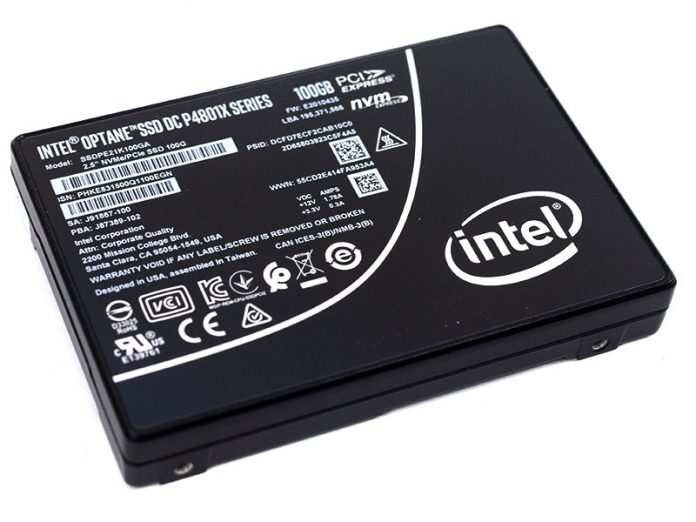One of the more intriguing options we have had in the STH lab recently is the Intel Optane DC P4801X U.2 NVMe SSD. In 2019, a 100GB NVMe SSD is considered very small. What is more, the drive comes in a 15mm U.2 case, making it one of the larger NVMe SSDs on the market today in terms of dimensions. While we recently reviewed the Optane DC P4801X M.2 drive, the difference in physical packaging changes how we view the drive.
Although this setup is good for 550K (read) 250K (write) 4K random IOPS and 2.2GB/s/ 1GB/s sequential read/ write speeds, these are hard numbers to see as useful. If you want that level of performance, there are larger NVMe SSDs that cost less than 1/20th of this drive per gigabyte. Since at STH we test ZFS ZIL/ SLOG devices, we saw the DC P4801X and think that it is a great fit for that role or for other similar log devices such as a Ceph log device.
Intel Optane DC P4801X Review 100GB U.2 Overview
In terms of packaging, the Intel Optane DC P4801X 100GB U.2 drive utilizes the same black casing we have seen in other Optane SSDs. We put the Intel Optane 900P 280GB drive next to the Optane DC P4801X here. The chassis is the same, but the labeling for the 100GB U.2 drive is more in-line with data center drives designed to be used in hot swap trays.
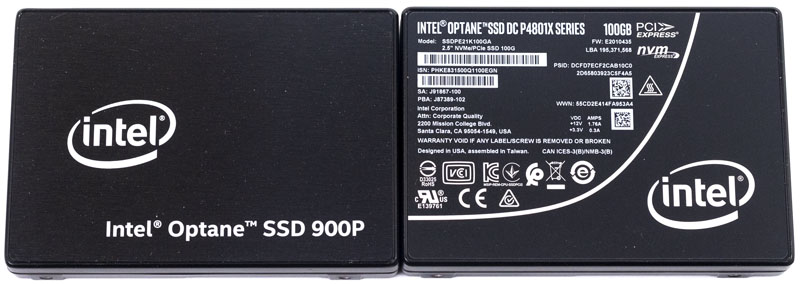
One can see the bottom of the drive here with its U.2 connector:
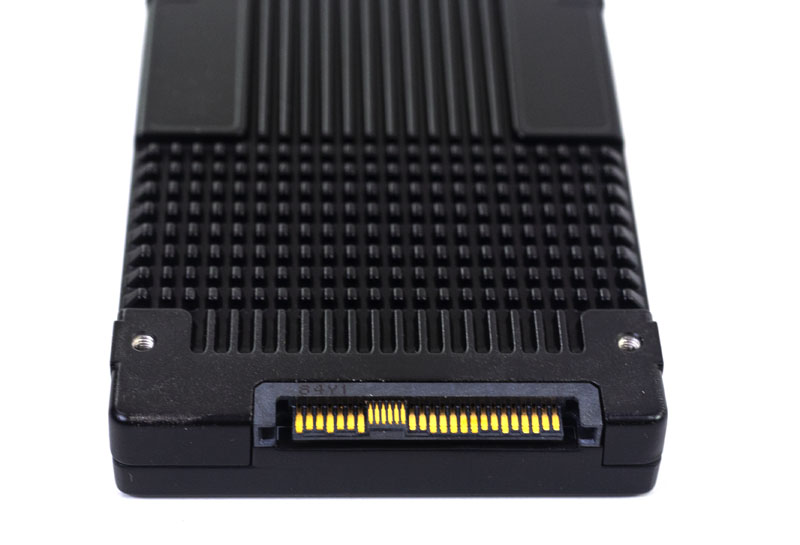
Quick specs on the Intel Optane DC P4801X 100GB U.2 SSD:
- Form Factor: 15mm U.2 PCIe 3.0 x4
- Endurance: 10.9PBW
- MTBF: 2M hours
- Power Max/ Idle: 7W/ 3W
- 4K Random IOPS: 550K (read)/ 250K (write)
- Sequential Read/ Write: 2.2GB/s (read)/ 1.0GB/s (write)
U.2 drives tend to cost more to connect to a server than M.2 SSDs. While slots can be plentiful, the backplanes and cables make the solution more costly. A 100GB SSD occupying a U.2 hot-swap bay is clearly not done to increase the capacity of the server. In 2019, it is hard to imagine why one would use a 100GB U.2 Intel Optane DC P4801X instead of a larger SSD unless there were two objectives:
- Take advantage of the low latency write speeds
- Take advantage of the high write endurance of Optane
When we think of that in a server context, that looks like a log/ write cache drive. For high-value databases, Intel makes better, larger, albeit more costly devices. If you only have a few U.2 SSD bays, then a 100GB device can be a tough decision to use. On the other hand, if you want an Intel Optane log device and cost is an enormous constraint, then the P4801X may make sense. Let us see how the drive performs.
Intel Optane DC P4801X Review 100GB U.2 ZFS ZIL/SLOG Performance
Here we are again using the FreeBSD diskinfo tool to simulate the type of activity patterns one sees with ZFS ZIL/ SLOG devices. Although the industry likes to quote 4K random write numbers, that is not the most relevant. A 100GB drive written continuously at 100% load will fill up quickly. Instead, logging operations often perform some writes, then need to flush data to make room for the next set of data.
We are cutting back the comparison points to make our charts a bit more reasonable, but we have now tested dozens of drives. Here is a comparison of the Intel Optane DC P4801X 100GB U.2 drive with other drives we have seen used as ZIL/ SLOG devices:
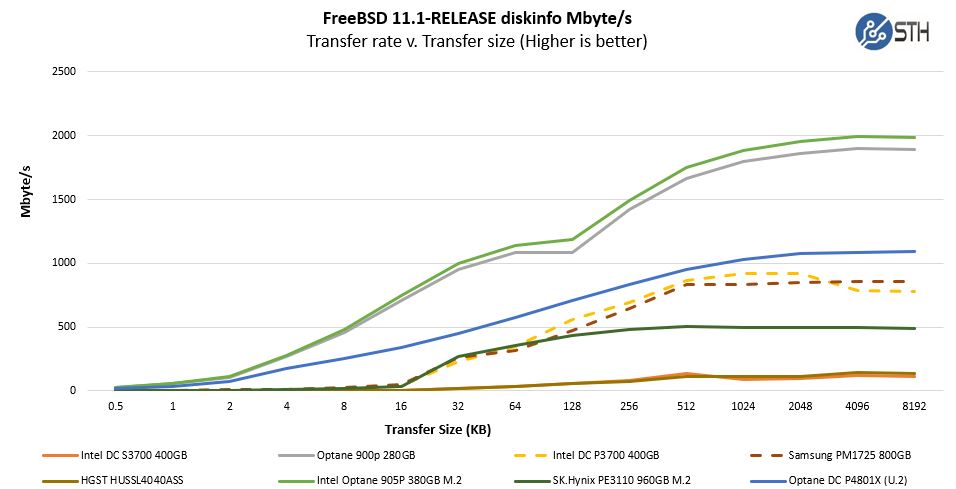
As you can see, the Optane U.2 drive performs very well at lower transfer sizes. This throughput tops out well before other larger Intel Optane solutions and well before the PCIe 3.0 x4 interface bandwidth is consumed.
Throughput is nice, but often we want to see latency.
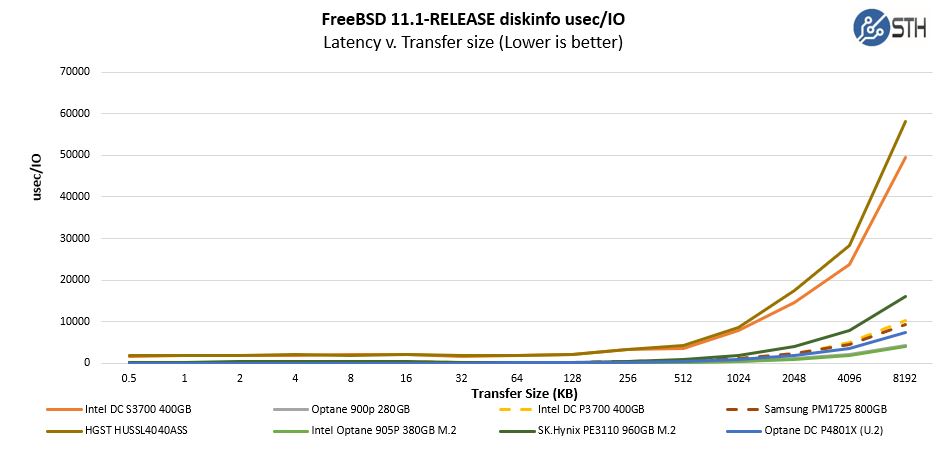
With the Intel Optane DC P4801X 100GB U.2 drive, as with other Intel Optane drives, it is very hard to see the results on this chart. The variance at low transfer sizes seems to converge along two curves. We can zoom into the lower transfer sizes to get a better view.
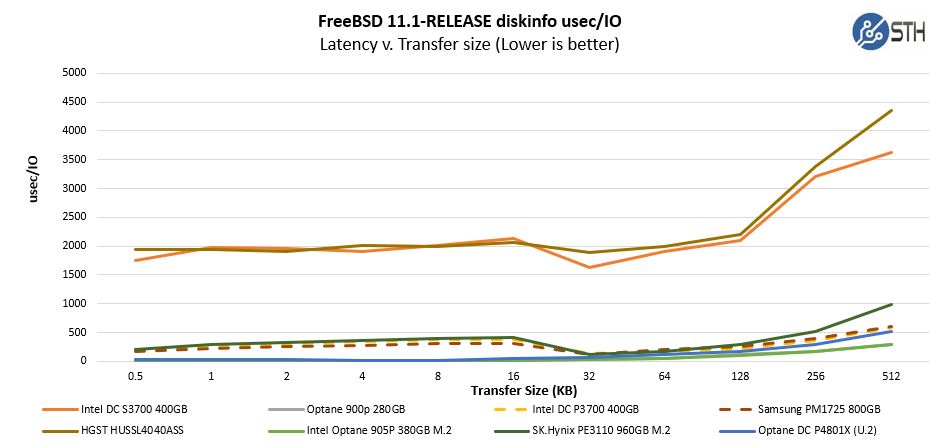
Here, the Intel Optane DC P4801X 100GB U.2 hugs the X-axis showing low latency. This is similar to what we have seen with other larger Intel Optane SSDs and is exactly what one wants with a ZFS ZIL/ SLOG device.
One can see the great performance at small file sizes. On the other hand, the Intel Optane DC P4801X is not fast enough to fully saturate higher-speed networking options found in servers. 10GbE is not an issue at these speeds, but this is not the answer for log devices that are expected to keep up at 40GbE/ 50GbE speeds.
Final Words
On one hand, the Intel Optane DC P4801X 100GB U.2 NVMe SSD at under $270 fills a gap where a log device is needed and budgets are thin. The drive is still less costly than putting Intel Optane DCPMM into a server, and we will have a comparison with that option soon.
Write endurance is rated at 10.9PBW which is more than most storage systems will see, especially those that are using $270 log devices. If you have a 10GbE class ZFS node or even a Ceph node and adding a write log device in front of a disk is important, then this is a great low-cost option.
Let us be clear, for any use other than as a write log device, we cannot recommend the Intel Optane DC P4801X 100GB U.2 device. At $2.70 per GB it is too expensive when well performing NVMe SSDs are approaching $0.10 per GB. If you do not need a dedicated heavy write-log device, get something else.
For systems integrators, and OEMs, the Intel Optane DC P4801X 100GB U.2 NVMe SSD has another important facet. If you are building commercial solutions, this drive comes with features like a 2M hour MTBF and end-to-end data protection. These are standard specs for the industry, and above what “prosumer” Optane offerings have. If you use an Intel Optane 905P drive in your product, and the device fails, a customer may question your choice of a prosumer drive. With the P4801X, this is Intel’s supported data center solution.
As we have tested the device and had both it and the M.2 version in our lab for some time, the question is whether it is worthwhile. Since 1PB written would be about the maximum we plan for on low-end storage server equipped with only 10GbE, the Optane 900p/ 905p we see as a better value. They are faster and higher capacity with a lower cost per GB.
NAND and DRAM prices have been falling in early 2019. Those trends make one admire the performance of the Intel Optane DC P4801X, but make it hard to justify the value except in some niche instances.

